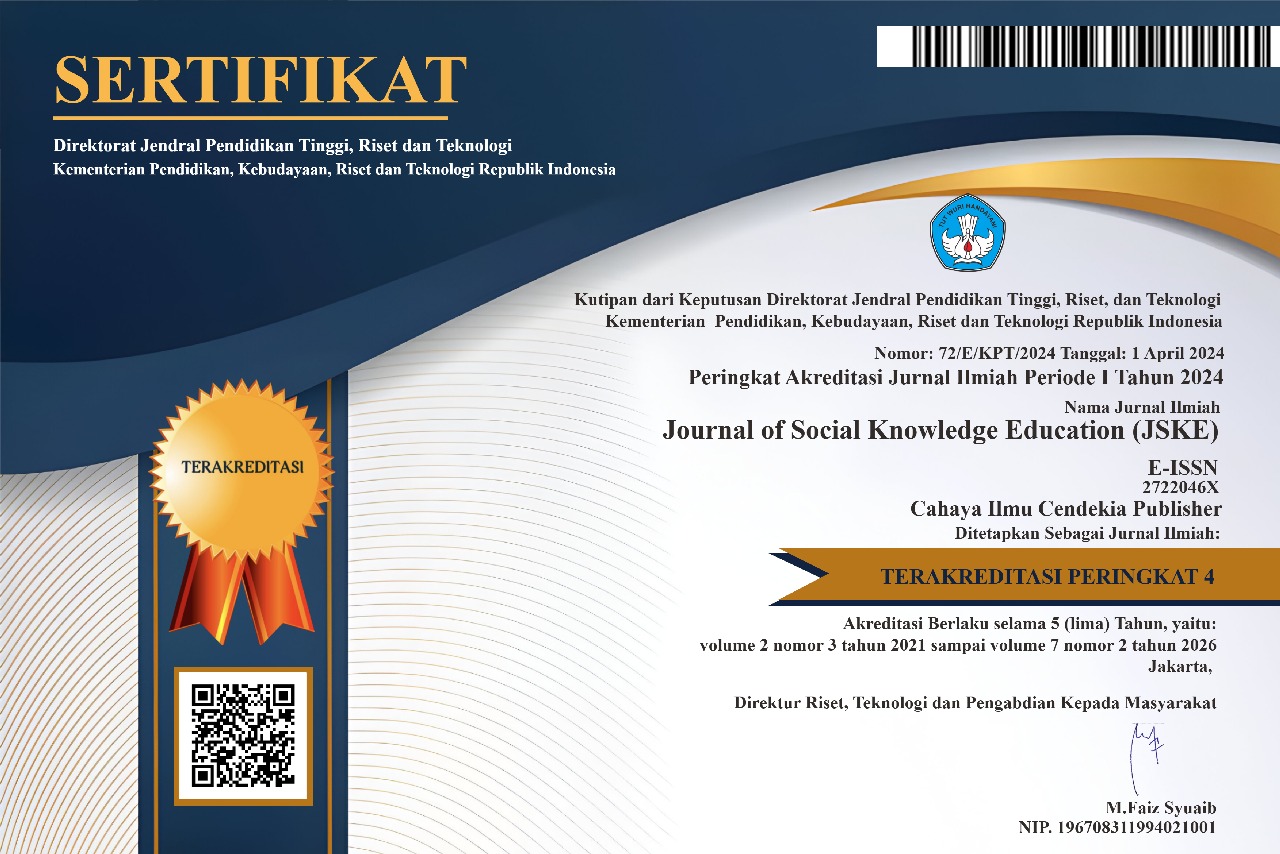The Relationship Between Students' Attitudes Towards Geography Lessons and Learning Motivation and Geography Learning Achievement
Abstract
Purpose of the study: The aim of this research is to determine the relationship between students' attitudes towards geography lessons and the relationship between learning motivation and students' geography learning achievement.
Methodology:This research is a descriptive study whose population is all high schools in Surakarta. The sample for this research was 79 students of class XI IPS. Data collection is carried out through questionnaires, tests, observations and documents. The data was then analyzed using multiple linear regression with three analysis prerequisites: normality test, multicollinearity test, and heterogeneity test.
Main Findings: The findings of this research are as follows. First, there is no positive correlation between students' attitudes towards Geography and their learning outcomes. This is indicated by a probability value of 0.231; which is higher than 0.05. Second, there is a positive relationship between student motivation and learning outcomes, with a probability value of 0.018. The third finding is that there is a simultaneous relationship between students' attitudes and motivation and their learning outcomes, with a probability value of 0.033.
Novelty/Originality of this study: The novelty of this research is that it provides information about the relationship between students' attitudes towards geography lessons and learning motivation with students' geography learning outcomes so that it can be used as material for consideration in learning strategies by Geography subject teachers.
References
R. Fitriani et al., “Mendeskripsikan Keterampilan Proses Sains Siswa melalui Kegiatan Praktikum Viskositas di SMAN 1 Muaro Jambi,” PENDIPA J. Sci. Educ., vol. 5, no. 2, pp. 173–179, 2021.
M. Wulandari, R. P. Wirayuda, F. Aldila, and R. Wulandari, “Description of Students’ Integrated Science Process Skills on Friction Material on a Flat Field,” Lensa J. Kependidikan Fis., vol. 8, no. 2, pp. 93–103, 2020, doi: 10.33394/j-lkf.v8i2.3206.
Darmaji, D. A. Kurniawan, E. Febri, and S. Rini, “Science Processing Skill and Critical Thinking : Reviewed Based on the Gender,” J. Pendidik. Indones., vol. 11, no. 1, pp. 133–141, 2022.
A. Sanova, A. Bakar, A. Afrida, D. A. Kurniawan, and F. T. Aldila, “Digital Literacy on the Use of E-Module Towards Students’ Self-Directed Learning on Learning Process and Outcomes Evaluation Cources,” JPI (Jurnal Pendidik. Indones., vol. 11, no. 1, pp. 154–164, 2022, doi: 10.23887/jpi-undiksha.v11i1.36509.
M. Iqbal, A. A. B. Ginting, F. T. Aldila, W. A. Putri, S. Maryani, and T. Ratnawati, “Hubungan Persepsi Siswa dalam Penggunaan Web-Based Assessment dengan Karakter Siswa di SMPN 2 Batanghari,” J. Pendidik. Edutama, vol. 9, no. 1, pp. 51–60, 2022.
M. M. Matondang, E. F. Setiya Rini, N. D. Putri, and F. Yolviansyah, “Uji Perbandingan Motivasi Belajar Siswa Kelas XI MIPA 2 dan XII MIPA 2 di SMA Negeri 1 Muaro Jambi,” J. Sains dan Pendidik. Fis., vol. 16, no. 3, p. 218, 2020, doi: 10.35580/jspf.v16i3.15553.
F. T. Aldila, M. M. Matondang, and L. Wicaksono, “Identifikasi Minat Belajar Siswa terhadap Mata Pelajaran Fisika di SMAN 1 Muaro Jambi,” J. Sci. Educ. Pract., vol. 4, no. 2, pp. 22–31, 2020.
S. Mundarti and F. T. Aldila, “Affective Assessment Instrument Based on Krathwohl-Anderson Taxonomy in Senior High School,” J. Eval. Educ., vol. 4, no. 2, pp. 74–79, 2023, doi: 10.37251/jee.v4i2.323.
E. F. Setiya Rini, D. Darmaji, and D. A. Kurniawan, “Identifikasi Kegiatan Praktikum dalam Meningkatkan Keterampilan Proses Sains di SMPN Se-Kecamatan Bajubang,” Edukatif J. Ilmu Pendidik., vol. 4, no. 2, pp. 2476–2481, 2022.
B. C. Putri, F. T. Aldila, and M. M. Matondang, “Hubungan Antara Karakter Motivasi Belajar dengan Hasil Belajar Siswa,” Integr. Sci. Educ. J., vol. 3, no. 2, pp. 45–49, 2022.
A. Asrial, S. Syahrial, D. A. Kurniawan, F. T. Aldila, and M. Iqbal, “Gender and Perception: Implementation of Web-based Character Assessment on Students’ Character Outcomes,” Int. J. Instr., vol. 15, no. 4, pp. 311–338, 2022, doi: 10.23887/jere.v6i1.37737.
F. T. Aldila, D. Darmaji, and D. A. Kurniawan, “Analisis Respon Pengguna terhadap Penerapan Web-based Assessment pada Penilaian Sikap Siswa terhadap Mata Pelajaran IPA dan Nilai-nilai Pendidikan Karakter,” Edukatif J. Ilmu Pendidik., vol. 4, no. 1, pp. 1253–1262, 2022, doi: 10.31004/edukatif.v4i1.2091.
W. A. Putri, R. Fitriani, E. F. Setya Rini, F. T. Aldila, and T. Ratnawati, “Pengaruh Motivasi terhadap Hasil Belajar Siswa Sekolah Menengah Pertama,” SAP (Susunan Artik. Pendidikan), vol. 5, no. 3, pp. 248–254, 2021, doi: 10.36987/jpms.v7i1.1942.
A. Ramadhanti, K. Kholilah, R. Fitriani, E. F. S. Rini, and M. R. Pratiwi, “Hubungan Motivasi Terhadap Hasil Belajar Fisika Kelas X MIPA di SMAN 1 Kota Jambi,” J. Eval. Educ., vol. 3, no. 2, pp. 60–65, 2022.
A. Dagnew, “The relationship between students’ attitudes towards school, values of education, achievement motivation and academic achievement in gondar secondary schools, Ethiopia,” Res. Pedagog., vol. 7, no. 2, pp. 30–42, 2017, doi: 10.17810/2015.46.
Darmaji, Astalini, D. A. Kurniawan, and F. T. Aldila, “Students’ Perceptions in the Use of Web-Based Character Assessment: A View from Gender Perspective,” J. Pendidik. Progresif, vol. 11, no. 2, pp. 362–383, 2021, doi: 10.23960/jpp.v.
D. Darmaji, A. Astalini, D. A. Kurniawan, F. T. Aldila, and H. Pathoni, “Gender and Perception: Implementation of Web-based Character Assessment in Science Learning,” J. Educ. Res. Eval., vol. 6, no. 1, pp. 131–142, 2022, doi: 10.23887/jere.v6i1.37737.
Asrial, Syahrial, D. A. Kurniawan, F. T. Aldila, and M. Iqbal, “Implementation of Web-based Character Assessment on Students’ Character Outcomes: A Review on Perception and Gender,” J. Technol. Sci. Educ., vol. 13, no. 1, pp. 301–328, 2023, doi: 10.29333/iji.2022.15418a.
F. T. Aldila and E. F. S. Rini, “Teacher’s Strategy in Developing Practical Values of the 5th Pancasila Preepts in Thematic Learning in Elementary School,” J. Basic Educ. Res., vol. 4, no. 1, 2023.
F. T. Aldila, E. F. S. Rini, S. W. Oktavia, N. N. Khaidah, F. P. Sinaga, and N. Sinaga, “The Relationship of Teacher Teaching Skills and Learning Interests of Physics Students of Senior High School,” EduFisika J. Pendidik. Fis., vol. 8, no. 1, 2023.
N. M. A. S. Paramita, N. W. Rati, and N. K. D. Tristiantari, “Pengaruh Model Pembelajaran Picture and Picture Berorientasi Pendidikan Karakter terhadap Motivasi Belajar IPS Siswa Kelas V,” J. Educ. Technol., vol. 3, no. 1, pp. 1–8, 2019, doi: http://dx.doi.org/10.23887/jet.v3i1.17957.
A. Ridlo, “Deskripsi Sikap Siswa dalam Mata Pelajaran IPA di SMP IT Ashidiqi,” J. Eval. Educ., vol. 1, no. 2, pp. 32–36, 2020, doi: 10.37251/jee.v1i2.42.
A. Astalini, D. A. Kurniawan, D. Darmaji, and N. Kurniawan, “Analisis Sikap Siswa terhadap IPA di SMP Kabupaten Muaro Jambi,” J. Pendidik. Sains, vol. 8, no. 1, pp. 18–26, 2020, doi: 10.26714/jps.8.1.2020.18-26.
Astalini and D. A. Kurniawan, “PENGEMBANGAN INSTRUMEN SIKAP SISWA SEKOLAH MENENGAH PERTAMA TERHADAP MATA PELAJARAN IPA,” J. Pendidik. Sains, vol. 07, no. 1, pp. 1–7, 2019, [Online]. Available: https://core.ac.uk/download/pdf/11715904.pdf.
M. Kamaluddin, “Pengaruh Motivasi Belajar terhadap Prestasi Belajar Matematika dan Strategi untuk Meningkatnya,” Semin. Matermatika dan Pendidik. Mat., pp. 455–460, 2017.
A. T. Rahmah, A. Aniswita, and H. Fitri, “Pengaruh Motivasi Belajar Siswa terhadap Kemampuan Pemecahan Masalah Matematika Siswa di Kelas VIII MTSN 3 Agam Tahun Pelajaran 2018/2019,” J. Ilm. Pendidik. Mat. Al Qalasadi, vol. 4, no. 1, pp. 56–62, 2020, doi: 10.32505/qalasadi.v4i1.1174.
F. M. Leo, A. Mouratidis, J. J. Pulido, M. A. López-Gajardo, and D, Sánchez-Oliva, “Perceived teachers’ behavior and students’ engagement in physical education: The mediating role of basic psychological needs and self-determined motivation,” Physical Education and Sport Pedagogy, vol. 27, no. 1, pp. 59-76, 2022.
N. H. Tien, and N. H. Manh, “Solutions to Enhance Working Motivation in International High School Education in Vietnam,” Journal of Critical Reviews, vol. 8, no. 2, pp. 167-176, 2021.
A. Rahardjo, and S. Pertiwi, “Learning motivation and students’ achievement in learning English,” JELITA, vol. 1, no. 2, pp. 56-64, 2020.
F. Martela, N. Hankonen, R. M. Ryan, and M. Vansteenkiste, "Motivating voluntary compliance to behavioural restrictions: Self-determination theory–based checklist of principles for COVID-19 and other emergency communications," European Review of Social Psychology, vol. 32, no. 2, pp. 305-347, 2021.
Y. B. Sitopu, K. A. Sitinjak, and F. K. Marpaung, "The influence of motivation, work discipline, and compensation on employee performance," Golden Ratio of Human Resource Management, vol. 1, no. 2, pp. 72-83, 2021.
R. W. Astuti, H. Fitria, and R. Rohana, "The influence of leadership styles and work motivation on teacher’s performance," Journal of Social Work and Science Education, vol. 1, no. 2, pp. 105-114, 2020.
R. Rafiola, P. Setyosari, C. Radjah, and M. Ramli, "The effect of learning motivation, self-efficacy, and blended learning on students’ achievement in the industrial revolution 4.0," International Journal of Emerging Technologies in Learning (iJET), vol. 15, no. 8, pp. 71-82, 2020.
M. R. Krou, C. J. Fong, and M. A. Hoff, "Achievement motivation and academic dishonesty: A meta-analytic investigation," Educational Psychology Review, vol. 33, pp. 427-458, 2021.
T. Wahjoedi, "The effect of organizational culture on employee performance mediated by job satisfaction and work motivation: Evident from SMEs in Indonesia," The effect of organizational culture on employee performance mediated by job satisfaction and work motivation: Evident from SMEs in Indonesia, vol. 11, no. 7, pp. 2053-2060, 2021.
A. Eliyana, S. Rohmatul, A. R. Sridadi, A. Razaq, D. R. Gunawan, "The Role of Motivation on Attitudes and Entrepreneur Achievement," Systematic Reviews in Pharmacy, vol. 11, no. 8, 2020.
H. Rose, S. Curle, I. Aizawa, and G. Thompson, "What drives success in English medium taught courses? The interplay between language proficiency, academic skills, and motivation," Studies in Higher Education, vol. 45, no. 11, pp. 2149-2161, 2020.
S. Susilawati, and T. Supriyatno, "Online learning through WhatsApp group in improving learning motivation in the era and post pandemic COVID-19," Jurnal Pendidikan: Teori, Penelitian, dan Pengembangan, vol. 5, no. 6, pp. 852-859, 2020.
M. Paais, and J. R. Pattiruhu, "Effect of motivation, leadership, and organizational culture on satisfaction and employee performance," The journal of asian finance, economics and business, vol. 7, no. 8, pp. 577-588, 2020.
N. A. Boudadi, and M. Gutiérrez-Colón, "Effect of Gamification on students’ motivation and learning achievement in Second Language Acquisition within higher education: a literature review 2011-2019," The EuroCALL Review, vol.. 28, no. 1, pp. 57-69, 2020.
Copyright (c) 2023 Rosi Elvia, Adetoun Gladys Emiola, Pham Thi Ngoc Quynh

This work is licensed under a Creative Commons Attribution-NonCommercial 4.0 International License.
Authors who publish with this journal agree to the following terms:
- Authors retain copyright and acknowledge that the Journal of social knowledge education (JSKE) is the first publisher licensed under a Creative Commons Attribution 4.0 International License.
- Authors are able to enter into separate, additional contractual arrangements for the non-exclusive distribution of the journal's published version of the work (e.g., post it to an institutional repository or publish it in a book), with an acknowledgment of its initial publication in this journal.
- Authors are permitted and encouraged to post their work online (e.g., in institutional repositories or on their website) prior to and during the submission process, as it can lead to productive exchanges and earlier and greater citation of published work.






.png)
.png)















